2012年最新人教版七年级下册英语金太阳UNIT5导学案及答案
- 格式:doc
- 大小:1.84 MB
- 文档页数:16

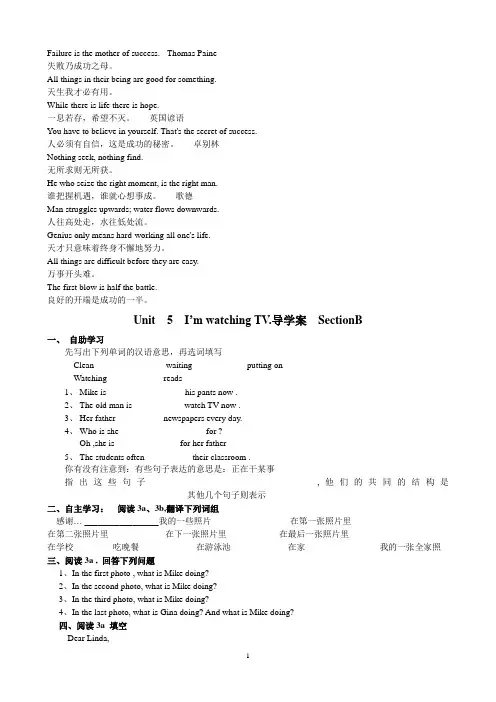
Failure is the mother of success. - Thomas Paine失败乃成功之母。
All things in their being are good for something.·天生我才必有用。
While there is life there is hope.一息若存,希望不灭。
-- 英国谚语You have to believe in yourself. That's the secret of success.人必须有自信,这是成功的秘密。
-- 卓别林Nothing seek, nothing find.无所求则无所获。
He who seize the right moment, is the right man.谁把握机遇,谁就心想事成。
-- 歌德Man struggles upwards; water flows downwards.人往高处走,水往低处流。
Genius only means hard-working all one's life.天才只意味着终身不懈地努力。
All things are difficult before they are easy.万事开头难。
The first blow is half the battle.良好的开端是成功的一半。
Unit 5 I’m watching TV.导学案SectionB一、自助学习先写出下列单词的汉语意思,再选词填写Clean ______________ waiting _________ putting on _______________________Watching ____________ reads ___________1、Mike is _________________ his pants now .2、The old man is ___________ watch TV now .3、Her father __________ newspapers every day.4、Who is she ___________________ for ?Oh ,she is ______________ for her father5、The students often __________ their classroom .你有没有注意到:有些句子表达的意思是:正在干某事指出这些句子______________________________________,他们的共同的结构是___________________________ 其他几个句子则表示____________________________二、自主学习:阅读3a、3b,翻译下列词组感谢… _________________我的一些照片_________________ 在第一张照片里_______________在第二张照片里_____________在下一张照片里__________ 在最后一张照片里_____________在学校_________吃晚餐_____________在游泳池_____________在家________________我的一张全家照三、阅读3a , 回答下列问题1、In the first photo , what is Mike doing?2、In the second photo, what is Mike doing?3、In the third photo, what is Mike doing?4、In the last photo, what is Gina doing? And what is Mike doing?四、阅读3a 填空Dear Linda,____________(谢谢) your letter and the photos. Here are _____________(我的一些照片). In the _______ photo, I________________(正在打篮球)______school. In the __________(two) photo, I ___________(正在游泳)_______ the pool. ______ the ______(下一张照片里) you can see _____________(我的家人) at home.We ________(在吃晚餐)。

课题:Unit5 Why do you like pandas? Section B (1a-1d)课型:听说课课时:2课时(第1课时导学、独学、互学、小展示;第2课时大展示、评学)学习目标:1.掌握本单元动物名词及描述动物特性的形容词或短语。
2.掌握由what,why 引导的特殊疑问句及其答语。
3.运用英语谈论、描述动物并说明喜欢某种动物的原因。
重、难点:能够辨别英语中的男名和女名并且准确的介绍自己的家庭成员。
独学准备:1.试读。
完成随堂笔记一;当堂测评分层达标基础落实★一、单项选择:从下列各题所给的四个选项中,选出一个可填入空白处的最佳答案。
(15分)( ) 1. —What animals only live in China?—________ do.A. ElephantsB. KoalasC. PandasD. Giraffes( ) 2. —Let’s go to see the pandas first.—________. Let’s see the tigers.A. N o, we can’tB. You are welcomeC. That’s boringD. OK. Let’s go( )3. —What’s that in the park?—It’s a baby elephant. It’s ________ interesting.A. littleB. a kind ofC. kinds ofD. kind of( )4. —Do you like tigers?—No, I don’t.They’re ________.A. excitingB. friendlyC. scaryD. shy( )5. —________ does your friend go to the zoo?—Because he wants to see animals.A. WhyB. WhereC. HowD. What二、完形填空:先阅读短文,然后从每小题所给的四个选项中,选出一个可以填入短文相应空白处的最佳答案。
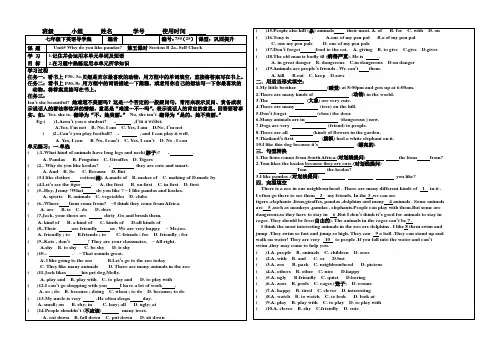
班级小组姓名学号使用时间七年级下英语导学案编者编号:755(25)课型:巩固提升课题Unit5 Why do you like pandas? 第五课时Section B 2a- Self Check学习目标1.记住并会运用本单元单词及短语2.在习题中熟练运用本单元所学知识学习过程任务一:看书上P30- 3a,贝姬是吉尔最喜欢的动物,用方框中的单词填空,直接将答案写在书上。
任务二:看书上P30-3b ,用方框中的词语描述一下熊猫,或者用你自己的想法写一下你最喜欢的动物。
将答案直接写在书上。
任务三:Isn’t she beautiful? 她难道不美丽吗?这是一个否定的一般疑问句,常用来表示反问、责备或表示说话人的看法和惊异的情绪,意思是“难道…不…吗”,表示说话人的肯定的意思。
回答要看事实。
如:Yes, she is. 翻译为“不,她美丽。
”No, she isn’t .翻译为“是的,她不美丽。
”Eg:( )1-Aren’t you a student? - ,I’m a writer.A.Yes, I’m notB. No, I amC. Yes, I amD.No, I’m not( )2.-Can’t you play football? - , and I can play it well.A. Yes, I canB. No, I can’tC. Yes, I can’tD. No , I can单元练习:一.单选( ).1-What kind of animals have long legs and neck(脖子)? - .A. PandasB. PenguinsC. GiraffesD. Tigers( )2.- Why do you like koalas? - they are cute and smart.A. AndB. SoC. BecauseD. But( )3.I like clothes cotton(棉). A.made of B. makes of C. making of D.made by( )4.Let’s see the tiger . A. the first B. on first C. in first D. first( )5.-Hey, Jenny !What do you like ? – I like pandas and koalas.A. sportsB. animalsC. vegetablesD. clubs( )6.-Where lions come from? –I think they come from Africa.A. areB. isC. doD. does( )7.Jack, your shoes are dirty .Go and brush them.A. kind ofB. a kind ofC. kinds ofD.all kinds of( )8.-Their are friendly us . We are very happy. – Me,too.A. friendly ; toB.friends ; toC. friends ; forD. friendly ; for( )9.-Kate , don’t ! They are your classmates. – All right.A.shyB. to shyC. be shyD. is shy( )10.- . – That sounds great.A. l like going to the zooB.Let’s go to the zoo todayC. They like many animalsD. There are many animals in the zoo( )11.Jack likes his pet dog,Molly.A. play andB. play withC. to play andD. to play with( )12.I can’t go shopping with you I have a lot of work .A. so ; doB. because ; doingC. when ; to doD. because; to do( )13.My uncle is very .He often sleeps day.A. small; onB. shy; inC. lazy; allD. ugly; at( )14.People shouldn’t (不应该) many trees.A. cut downB. fall downC. put downD. sit down ( )15.People also kill (杀) animals their meat. A. of B. for C. with D. on ( )16.Tony is . A.one of my pen pal B.a of my pen palC. one my pen palsD. one of my pen pals( )17.Don’t forget food to the cat. A. giving B. to give C.give D.gives ( )18.The old man is badly ill (病得严重). He is .A. in great dangerB. dangerousC.in dangerousD.on danger( )19.Animals are people’s friends . We can’t them.A. killB.cutC. keepD.save二.用适当形式填空:1.My little brother (睡觉) at 8:00pm and gets up at 6:00am.2.There are many kinds of (动物) in the world.3.The (大象) are very cute.4.There are many (tree) on the hill.5.Don’t forget (close) the door.6.Many animals are in (dangerous ) now.7.Dogs are very (friend) to people.8.There are all (kind) of flowers in the garden.9.Thailand’s first (旗帜) had a white elephant on it.10.I like this dog because it’s (漂亮的).三.句型转换1.The lions comes from South Africa.(对划线提问) the lions from?2.Tom likes the koalas because they are cute.(对划线提问)Tom the koalas?3.I like pandas .(对划线提问) you like?四.完型填空There is a zoo in our neighbourhood . There are many different kinds of 1 in it .I often go there to see them 2 my friends. In the 3 ,we can seetigers ,elephants ,lions,giraffes, pandas ,dolphins and many 4 animals . Some animals are 5 ,such as monkeys ,pandas , elephants.People can play with them.But some are dangerous,so they have to stay in 6 .But I don’t think it’s good for animals to stay in cages. They should be free(自由的). The animals in the cages can’t be 7 .I think the most interesting animals in the zoo are dolphins . I like 8 them swim and jump .They swim so fast and jump so high. They can 9 a ball .They can stand up and walk on water! They are very 10 to people .If you fall into the water and can’t swim ,they may come to help you.( )1.A. people B. animals C. children D. zoos( )2.A. with B. and C. or D.but( )3.A. zoo B. park C. neighbourhood D. pictrue( )4.A. others B. other C. nice D.happy( )5.A. ugly B.friendly C. quiet D.boring( )6.A. zoos B. pools C. cages (笼子) D. rooms( )7.A. happy B. tired C. clever D. interesting( )8.A. watch B. to watch C. to look D. look at( )9.A. play B. play with C. to play D. to play with( )10.A. clever B. shy C.friendly D. cute。
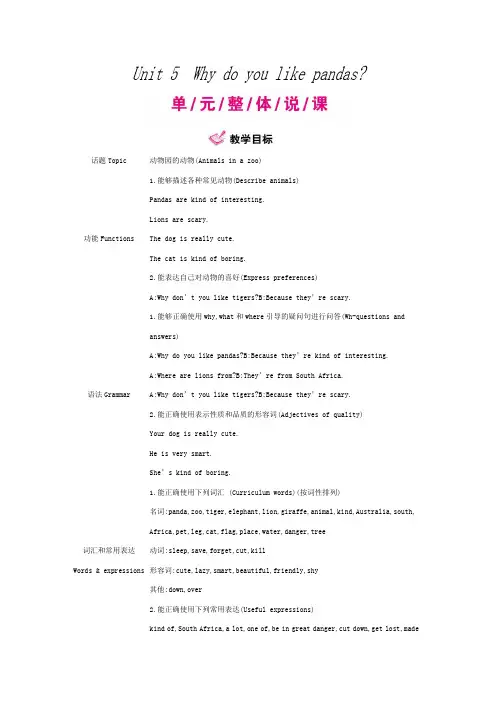
Unit 5 Why do you like pandas?话题Topic 动物园的动物(Animals in a zoo)功能Functions 1.能够描述各种常见动物(Describe animals)Pandas are kind of interesting.Lions are scary.The dog is really cute.The cat is kind of boring.2.能表达自己对动物的喜好(Express preferences)A:Why don’t you like tigers?B:Because they’re scary.语法Grammar 1.能够正确使用why,what和where引导的疑问句进行问答(Wh-questions and answers)A:Why do you like pandas?B:Because they’re kind of interesting.A:Where are lions from?B:They’re from South Africa.A:Why don’t you like tigers?B:Because they’re scary.2.能正确使用表示性质和品质的形容词(Adjectives of quality)Your dog is really cute.He is very smart.She’s kind of boring.词汇和常用表达Words & expressions 1.能正确使用下列词汇 (Curriculum words)(按词性排列)名词:panda,zoo,tiger,elephant,lion,giraffe,animal,kind,Australia,south, Africa,pet,leg,cat,flag,place,water,danger,tree动词:sleep,save,forget,cut,kill形容词:cute,lazy,smart,beautiful,friendly,shy其他:down,over2.能正确使用下列常用表达(Useful expressions)kind of,South Africa,a lot,one of,be in great danger,cut down,getlost,madeof3.能认读下列词汇(Non-curriculum words) koala,scary,Thailand,symbol,ivory,Thai学习策略Strategies 1.能借助上下文语境猜出部分词汇的含义2.能够根据词汇的含义、性质、特点等分类记忆单元词汇3.能根据阅读语篇内容构建思维导图4.能通过各种方式搜集有关动物的信息和资料文化知识Culture 了解世界各地的典型动物三维目标Three-dimensionaltarget 知识与技能1.能掌握以下单词:panda,zoo,tiger,elephant,koala,lion,giraffe,animal,cute,lazy,smart,beautiful,scary,kind,Australia,south,Africa,pet,leg,cat,sleep,friendly,shy,save,symbol,flag,forget,place,water,danger,cut,down,tree,kill,ivory,over,Thailand,Thai2.能熟练掌握单元短语:kind of,walk on two legs,South Africa,alot,one of,be in great danger,cut down,for a long time,getlost,made of3.能掌握以下句型:A:What animals do you like?B:I like koalas.三维目标Three-dimensionaltarget 知识与技能A:Why do you like koalas?B:Because they’re very cute.A:Where are koalas from?B:They’re from Australia.4.了解以下语法:(1)Wh-questions的意思、构成和回答:Why do you like pandas?Becausethey’re cute.Where are they from?They’re from China.(2)形容词表示性质、特点和品质:cute,beautiful,smart,lazy等。

units5-6 导学案一、复习内容:_Review of Units5-6复习目标:1.巩固Unit5-6重点单词、短语。
2.复习如何正确询问和表达对应话题。
二、定向导学·互动展示自学指导内容·学法·时间20′互动策略内容·形式·时间15′展示方案内容·形式·时间25′随堂笔记成果记录·知识生成·同步演练规范、高效、地完成下列自研任务。
小组长对自研成果进行等级评定。
一、我看词汇认真阅读课本P123-124页上Units5-6的单词部分,用自己喜欢的方式进行记忆,再关上书本完成随堂笔记中重点单词回眸的自我检测。
二、词组盘点回顾本单元所学重要短语,并进行记忆,关上书本后完成随堂笔记中重点短语PAIRWORK1. 对子间核对我看词汇和词组盘点中的内容,相互探讨纠错,形成统一答案。
Groupwork offour:小组内探讨句型必备中的已学句型,纠错答案,形成共识。
并齐读修正后的句子三遍。
展示单元一:词汇积累,人人过关1.板书随堂笔记部分的词汇和词组部分,组员轮流带读本单元单词。
2.解析单词填写的过程以及所需注意的重点。
展示单元二:语法积累,解惑释疑将句子翻译呈现在黑板上,带领全一、短语归纳1. kind of 有几分,有点儿2. be from来自于3. South Africa 南非4. all day 整天5. for a long time 很长时间6. get lost 迷路7. places with food and water 有食物和水的地8. cut down 砍倒9. in (great) danger 处于(极大)危险之中10. twelve years old 十二岁11. things made of ivory 由象牙制成的东西12.like...a lot 非常喜欢13.students from Thailand来自泰国的学生14.save the elephants 拯救大象15.a symbol of good luck幸运的象征16.lose on e’s home 失去家园17.walk on two legs用两条腿走路1. watch TV 看电视2. read a newspaper 看报纸3. talk on the phone 通过电话交谈4. listen to music 听音乐5. use the computer 使用电脑6. make soup做汤7. wash the dishes 洗餐具8. go to the movies去看电影9. wash cclothes洗衣服10..join me for dinner和我一起吃饭检测题。
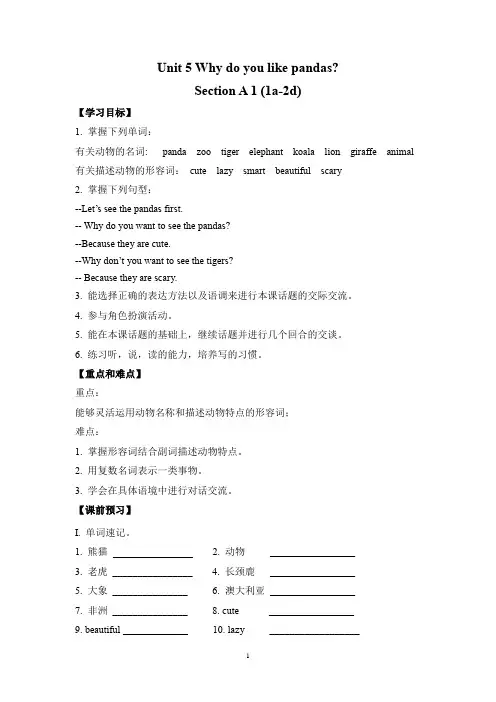
Unit 5 Why do you like pandas?Section A 1 (1a-2d)【学习目标】1. 掌握下列单词:有关动物的名词: panda zoo tiger elephant koala lion giraffe animal 有关描述动物的形容词:cute lazy smart beautiful scary2. 掌握下列句型:--Let’s see the pandas first.-- Why do you want to see the pandas?--Because they are cute.--Why don’t you want to see the tigers?-- Because they are scary.3. 能选择正确的表达方法以及语调来进行本课话题的交际交流。
4. 参与角色扮演活动。
5. 能在本课话题的基础上,继续话题并进行几个回合的交谈。
6. 练习听,说,读的能力,培养写的习惯。
【重点和难点】重点:能够灵活运用动物名称和描述动物特点的形容词;难点:1. 掌握形容词结合副词描述动物特点。
2. 用复数名词表示一类事物。
3. 学会在具体语境中进行对话交流。
【课前预习】I. 单词速记。
1. 熊猫2. 动物_________________3. 老虎________________4. 长颈鹿_________________5. 大象_______________6. 澳大利亚_________________7. 非洲_______________ 8. cute _________________9. beautiful _____________ 10. lazy __________________11. south ______________ 12. pet __________________13. sleep ______________ 14. zoo __________________II. 短语互译。

Unit 5 Why do you like pandas? (导学案)Period 3 (Section B 1a-1d)【学习目标】:描述动物,谈论喜好【学习难点】:能听懂有关谈论喜好的对话并进行自由交际【学习步骤】Step 1:【自主预习】1. 根据音标拼读单词并牢记;2. 自学课文,勾画出重点和疑惑3.英汉互译1. friendly _________________2. shy ________________3. 美丽的__________________4. 懒惰的_____________5.What animals do you like?______________________________6.它是白色和黑色。
_________________________7.它来自中国。
______________________ Step 2:【课堂导学】学习任务一:完成1a1.小组核对1a答案学习任务二:完成1b部分1.听录音,完成1b,并核对答案2.听录音,复述对话内容学习任务三:完成1c1.听录音,写出所用的形容词学习任务四:1.同学间练习1d的对话2.分角色表演1d对话Step 3:【呈现点评】Step 4:【教师点拨】:1.friendly 友好的friendly形容词,意为“友好的”,其反义词为unfriendly“不友好的”。
Eg: The old woman is very friendly. 那位老妇人非常友好。
拓展:(1)be friendly to sb.意思是“对某人友好”,指对别人的态度好、热情,相当于be kind to sb.。
Eg: My classmates are all friendly to me. 我同学都对我很友好。
(2)be friendly with sb. 意思是“和某人关系好”或“与某人要好”。
Eg: The classmates in our class are friendly with each other.我们班上的同学相互关系都很好。
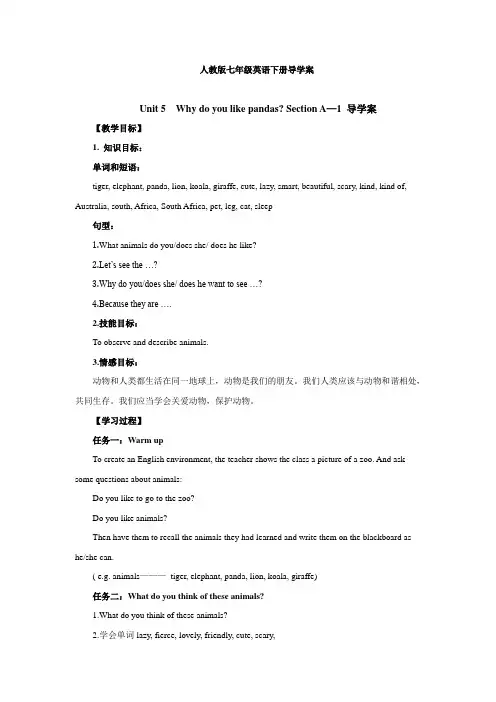
人教版七年级英语下册导学案Unit 5 Why do you like pandas? Section A—1 导学案【教学目标】1. 知识目标:单词和短语:tiger, elephant, panda, lion, koala, giraffe, cute, lazy, smart, beautiful, scary, kind, kind of, Australia, south, Africa, South Africa, pet, leg, cat, sleep句型:1.What animals do you/does she/ does he like?2.Let’s see the …?3.Why do you/does she/ does he want to see …?4.Because they are ….2.技能目标:To observe and describe animals.3.情感目标:动物和人类都生活在同一地球上,动物是我们的朋友。
我们人类应该与动物和谐相处,共同生存。
我们应当学会关爱动物,保护动物。
【学习过程】任务一:Warm upTo create an English environment, the teacher shows the class a picture of a zoo. And ask some questions about animals:Do you like to go to the zoo?Do you like animals?Then have them to recall the animals they had learned and write them on the blackboard as he/she can.( e.g. animals———tiger, elephant, panda, lion, koala, giraffe)任务二:What do you think of these animals?1.What do you think of these animals?2.学会单词lazy, fierce, lovely, friendly, cute, scary,3.询问动物来自哪里。

Unit5['pændə]n.熊猫[zu:] n.动物园['taɪgə(r)] n.老虎['elɪfənt] n.大象koala [kəʊ'ɑ:lə] n.['laɪən] n.狮子giraffe[dʒə'rɑ:f] n.['ænɪml] n.动物[kju:t] adj.可爱的;机灵的['leɪzɪ] adj.懒散的;懒惰的[smɑ:(r)t] adj.聪明的['bju:tɪfl] adj.美丽的;美好的['skeərɪ] adj.吓人的;恐怖的[kaɪnd] n.种类稍微;有点[ɒ'streɪlɪə] n.澳大利亚[saʊθ] adj.南方的n.南;南方['æfri:kə] n.非洲South Africa[pet] n.宠物[leg] n.腿[kæt] n.猫[sli:p] v.&n.睡觉['frendli]adj.友好的[ʃaɪ] adj.羞怯的;腼腆的[seɪv] v.救;救助['sɪmbl] n.象征[flæg] n.旗,旗帜[fə(r)'get] v.忘记;遗忘get lost[pleɪs] n.地点;位置['wɔ:tə] n.水['deɪndʒə(r)] n.危险be in (great) danger[kʌ:t] v.砍;切[daʊn]adv.(坐、躺、倒)下prep.向下、沿着cut down[tri:] n.树[kɪl] v.杀死;弄死['aɪvəri] n.象牙['əʊvə(r)]prep.超过;多于在……上方(be) made ofJulie ['dʒu:lɪ]朱莉( 名)Becky ['beki]贝姬( 名) Thailand ['taɪlænd]n. Thai [taɪ] n.词汇梳理zoo (n. 动物园)一(复数)beautiful (adj.美丽的)— (n.美丽,美人)friendly (adj. )一(n.朋友)一(n.友谊)danger (n.危险)一(adj.危险的)sleep (v. & n.睡觉)一(adj.睡着的,熟睡的)kill (v.杀死,弄死)— (n.杀手,杀人者)短语归纳kind ofwalk on two legs like... a lotone of. .....for a long time cut downlose one's home South Africaall dayblack and whitea symbol of. ........ get lostbe in (great) danger be made of用法总结1.询问原因及答语:①一Why +一般疑问句?为什么……?—Because ...因为①—Why don't ... ?为什么不.....?—Because ...因为2.询问某人/物来自哪里:Where + be +主语+ from?....来自哪里?3.提建议的句型:Let's do...咱们做.....吧。

Unit5 Why do you like pandas?(Section B 1a—2a)【学习目标】1.知识与技能目标:重要词汇:friendly, shy, smart, scary, lazy, beautiful.重点句型:1.—What animals do you like? —I like elephants.2. I like dogs because they are friendly and smart.2.过程与方法目标:通过听力训练来掌握和提高学生们综合听说能力。
3.情感态度与价值观目标:动物是我们的朋友,我们应该与动物和谐相处,共同生存。
提高学生关爱动物,保护动物的意识。
【重、难点】1.掌握描述动物的形容词,并运用正确的形容词来描述动物。
2.掌握句型:What animals do you like?一.回顾已知,导入新课1.它是白色和黑色吗?_____________________________________2.它来自中国。
_____________________________________3.我喜欢猴子因为它们聪明。
_____________________________________二.自主学习,边学边导1.自主学习新单词:翻译下列单词:shy ___________________ friendly ________________2.按要求完成1a中的练习;3.听力练习:听听力,完成1b和1c;4.完成下列对话并根据下列句型进行操练;A: What animals do you like? B: I like ________.A: Why? B: Because they are _____5.自主完成2a;讨论对濒危动物的看法及意见。
6.根据所学,尝试用英语描述动物三.精讲点拨,精练提升1.学会运用所学形容词描述动物I like elephants because they’re ________.I don’t like lions because they’re _________.2.学会询问他人喜欢什么动物What animals _____ you like? What animals _____ he like? What animals _____ they like? What animals _____ she like? 四.达标检测,当堂过关(一) 词汇短语检测:1.tiger_______ elephant_______ koala_______ dolphin_______ panda_______ lion_______ giraffe______ 吓人的__________宠物_______ 腿________ 猫_______ 睡觉____________2. 南非______________ 整天_____________ 黑白相间_____________ befrom_______________(二) 用下列单词的适当形式完成短文,每词只能用一次。
七年级一学期英语学科导学案(编号:)
古希腊哲学大师亚里士多德说:人有两种,一种即“吃饭是为了活着”,一种是“活着是为了吃饭”.一个人之所以伟大,首先是因为他有超于常人的心。
“志当存高远”,“风物长宜放眼量”,这些古语皆鼓舞人们要树立雄心壮志,要有远大的理想。
有一位心理学家到一个建筑工地,分别问三个正在砌砖的工人:“你在干什么?”
第一个工人懒洋洋地说:“我在砌砖。
” 第二个工人缺乏热情地说:“我在砌一堵墙。
” 第三个工人满怀憧憬地说:“我在建一座高楼!”
听完回答,心理学家判定:第一个人心中只有砖,他一辈子能把砖砌好就不错了;第二个人眼中只有墙,好好干或许能当一位技术员;而第三个人心中已经立起了一座殿堂,因为他心态乐观,胸怀远大的志向!
井底之蛙,只能看到巴掌大的天空;摸到大象腿的盲人,只能认为大象长得像柱子;登上五岳的人,才能感觉“一览众山小”;看到大海的人,就会顿感心胸开阔舒畅;
心中没有希望的人,是世界上最贫穷的人;心中没有梦想的人,是普天下最平庸的人;目光短浅的人,是最没有希望的人。
清代“红顶商人”胡雪岩说:“做生意顶要紧的是眼光,看得到一省,就能做一省的生意;看得到天下,就能做天下的生意;看得到外国,就能做外国的生意。
”可见,一个人的心胸和眼光,决定了他志向的短浅或高远;一个人的希望和梦想,决定了他的人生暗淡或辉煌。
Unit 5Why do you like pandas ?Section A 1a—2d(听说课)写 :王静核:熔挂科:黄金富使用者:____________教寄:Love me ,love my dog .屋及。
学习目标 :1.掌握本 :panda, zoo, tiger, elephant, koala, lion, giraffe, animal, cute, lazy,smart, beautiful, scary, kind, Australia, south, Africa, pet,leg, cat, sleep.2.重点短: kind of, South Africa, be from/ come from, walk on two legs, sleepall day.3.重点句型:——Why do you like pandas?——Because they are kind of cute.—— Where are they from?——They are from China.重点、难点 :1. 重点,短。
2.重点句型及听力口。
学习过程 :Step1 、感知(一)了解歌曲呈现:《Old Macdonald had a farm》,欣赏歌曲回答问题:1.How many kinds of animals are there on Old Macdonald had a farm ?2.Which animals have the “ moo” sound ?3.Where can we see more animals ?(二)初听材料1.听音 , 完成 1b 相 , 核答案。
2.与同伴完成 1c。
(三)疑___________________________________________________________step2 、内化(一)听材料1.听音,完成 2a,2b 和 2c.2. 呈听力材料,学生行模仿朗。
Unit5 Why do you like pandas? (学生用书)学习目标1. 能恰当地运用形容词及短语描述自己所喜欢的动物。
2. 采用模拟动物独特动作、小组交流合作、制作调查表格等方式来表达自己喜种动物的原因。
3.能通过各种途径了解一些常见的动物习性,能正确对待动物本身的优缺点,养成爱护动物,保护环境的良好品质。
Section A (1a-1c)课时重点能熟练运用所学过的形容词表达自己喜欢哪种动物的原因。
预习导学——不看不讲1.根据图片及提示写单词。
①你能用英语写出下列动物的名称吗?panda giraffe elephantlion tiger koala②你能用课本P25中的形容词来描述下面的QQ图像吗?cute smart beautiful lazy2.译一译①Let’s see the pandas first.让我们先去看熊猫吧。
②Why do you want to see them?Because they’re interesting.你为什么想去看他们呢?因为他们可爱啊。
③They’re my favorite animals.他们是我最喜欢的动物。
3、你还知道哪些动物的英文名字?快将其写在下面,看谁知道的最多。
合作探究——不议不讲活动一①仔细观察P25上1a的图片,小组为单位讨论2、3、4、5、6、所对应的动物,并代入对话进行模拟表演。
完成任务的语言结构:A: Let’s see the pandas first. They’re my favorite animals(I like them best).B: Why?C:Because they’re very cute.②假设我们来到了羊世界,你想先去看谁呢?与小组伙伴一起根据下面的图片练习对话,任务语言如下。
A: A: A:B: B: B:A: A: A:活动二①听P25上1b的磁带第一遍,完成1b 中的听力题,②听第二遍,仿照例句用完整的句子写出你所听到的动物的特点。
例句:Pandas are very cute.活动三①分小组完成P25上1c的活动,并请各组代表表演。
②组长做记者,调查组内同学最想去看的动物及原因,组员做记录:③根据调查表写调查报告。
例:Li Ning wants to see koalas,He thinks they’re very cute.知识超市Why do you want to see them? 你为什么想去看它们?①此句中的want to意为“想干某事”,后接动词。
如want to go home想回家。
②由Why引领的特殊疑问句一般都要用“Because……”句式来回答。
其否定形式只需把do改为don’t.如,Why don’t you want to see them? 你为什么不想去看它们?做一做:1)汉译英。
星期六你想去干什么?我想去打排球。
What do you want to do on Saturday? I want to play volleyball.2)根据括号里的提示完成下列各题。
I want to see giraffes because they’re very interesing.(对划线部分提问)Why do you want to see giraffes?知识链接树袋熊树袋熊又叫考拉、无尾熊、可拉熊,学名:Phascolarctos cinereus 英文:Koala bear来源于古代土著文字,意思是“no drink”。
因为树袋熊从他们取食的桉树叶中获得所需的90%的水分,而它们只在生病和干旱的时候喝水。
树袋熊每天18个小时处于睡眠状态,生活在澳大利亚,是澳大利亚奇特的珍贵原始树栖动物,属有袋哺乳类。
分布于澳大利亚东南部干旱森林中。
学法指导1. 建议课前先记住本课时新单词的读音及书写,以扫清听力障碍。
2. 学生可以借助课外书及学习工具了解更多动物的英文名词及其生活习性。
教学建议1、可以布置学生将本单元的一些动物画下来,以备课上使用;2、合作探究中的活动可以因班级实情而异,可以适当增删,可以适当调整。
备选问题1、let’s 和let us 的用法区别讲解吗?2、want to 和want的用法呢?达标测评一、选择正确的选项补全单词。
( A ) 1. eleph ____ t A. an B. on C. en( C ) 2. l _____ n A. ie B. oi C. io( B ) 3. g _____ affe A. ri B. ir C. ie( A ) 4. p _____ da A. an B. on C. en( B ) 5.. tig _____ A. ir B. er C. or( A ) 6.fr _____ dly A. ien B. ein C. ian( B ) 7.k _____ la A. ou B. oa C. oe( B ) 8.bec _____ se A. ou B. au C. oa( C ) 9.int_____sting A.ire B.ier C.ere( A ) 10.b_____tiful A.eau B.eu C.au二、组词成句。
1. want, koalas, to, the, do, you, see,whyWhy do you want to see the koalas ?2.interesting,are,because,theyBecause they are interesting .3. see, first, giraffes, the, let’sLet’s see the giraffes first .4. lions,my,favorite,animals,areLions are my favorite animals / My favorite animals are lions .三、短文填空(七选五)eats lazy cute relaxes years sleeps playsThis is Larry. He is eight_years_old. He _eats meat. Larry is _lazy_. He usually_relaxes_and_sleeps_20 hours every day.四、作文谈谈你一家分别最喜欢的动物,并说出理由。
不少于50字。
Section A (2a-2d)课时重点能轻松听录音,抓住重点词汇完成听力练习,并能用所学知识聊聊自己身边的宠物。
预习导学——不看不讲1.归类。
你能将这些形容词放到正确的地方吗?①Let’s see the koala first.②They’re fromSouth Africa.③Where are they from?④Why do you like them?⑤Because they’re not kind of cute,they’re very cute.A:B:A:B:A:合作探究——不议不讲活动一①仔细阅读P26上2a所给的信息,联系自己课外所掌握的有关知识,你能猜一猜听力材料里会说到哪些动物,它是来自哪个国家的?可以用铅笔先写下来你猜的答案。
②认真听P26上2a的磁带第一遍,完成2a中的听力题,确认一下,你的课外知识帮你猜对了几个答案。
③听第二遍,完成2b中的听力题。
④完成P26上2c的活动。
活动二①读P26上2d,回答下列问题。
1)What is Peter’s pet? What’s its name?A dog, Its name is Dingding.2)What can it do?It can walk on two legs and dance.3)What does Jenny’s mother like?She likes cats.4)Does Jenny like his mother’s pet?Why or Why not?No,he doesn’t.Because he think it’s boring.②完成P26上的2d。
活动三1)2)Chen Ning has a pet ,it’s a koala,He likes it very much because it’s cute.知识超市Where are they from?他们来自哪里?They are from Australia. 他们来自澳大利亚。
①此句中的be(am/is/are)from意为“来自”,后接地点名词。
如Iamfrom Jiangxi我来自江西。
②be from 可以用come from 代替。
如Where are they from?=Where do they come from? They are from Australia.可以用They come from Australia.代替。
做一做:1)汉译英。
你是哪里人?我来自中国。
Where are you from? I’m from China.或Where do you come from?I come from China.2)根据括号里的提示完成下列各题。
He comes from Shanghai.(同义句)He is from Shanghai.Are you come from South Africa?(改错)把Are 改为Do,或删掉come.知识链接南非共和国南非国旗你了解南非吗?南非地处南半球,有“彩虹之国”之美誉,位于非洲大陆的最南端,陆地面积为1219,090平方公里,其东、南、西三面被印度洋和大西洋环抱,北面与纳米比亚、博茨瓦纳、津巴布韦、莫桑比克和斯威士兰接壤。
南非是非洲最大经济体和最具影响力的国家之一,其国内生产总值约占撒哈拉以南非洲国家经济总量的三分之一,对地区经济发展起到了重要的引领作用。
南非财经、法律、通讯、能源、交通业发达,拥有完备的硬件基础设施和股票交易市场,生产量均占世界首位。
并且南非在2010年加入金砖国家,进一步与巴西、俄罗斯、印度、中国加强合作贸易交流。
学法指导1. 建议课前先记住本课时新单词的读音及书写,以扫清听力障碍。
2. 联系实际生活学习英语会更轻松。
教学建议1、可以布置学生了解身边动物的习性,并试着用英语介绍;2、合作探究中的活动大部分以小组为单位进行,教师作适当指导即可。
备选问题1、all day和all the day的用法区别讲解吗?2、why don’t you (why not)后接动词原形,用于提建议或意见的用法是否应该提到呢?达标测评一、根据提示补全单词,使句意完整。